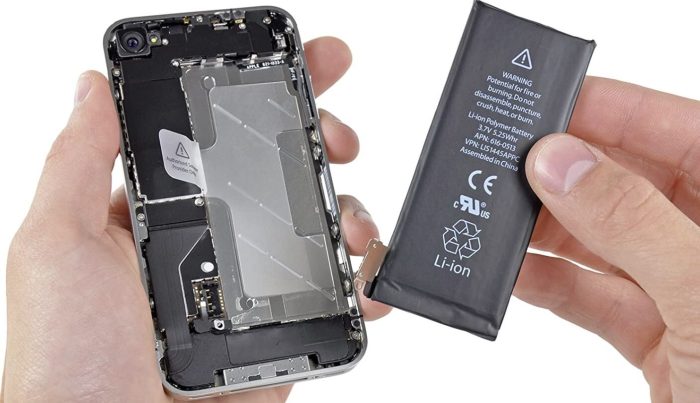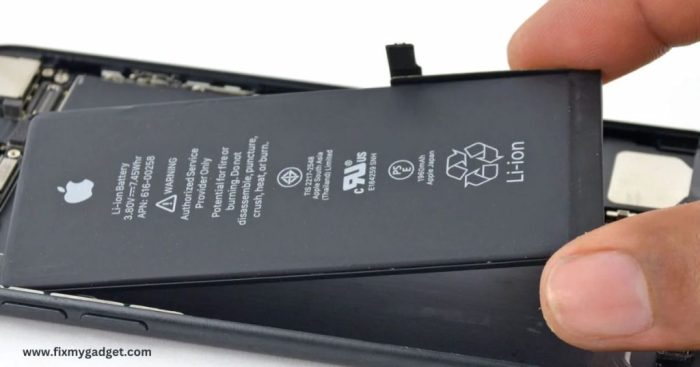Diagnostic Results and Battery Health
Your iPhone’s battery is a crucial component that powers your device, and like any other battery, it gradually degrades over time. Understanding the factors that contribute to battery degradation and the diagnostic tools Apple uses to assess battery health is essential for making informed decisions about your device’s longevity.
Factors Affecting Battery Degradation
Battery degradation is a natural process that occurs over time due to various factors.
- Charging Cycles: Each time you charge your iPhone’s battery from empty to full, it counts as a charging cycle. Over time, the number of charging cycles can lead to a decrease in battery capacity.
- Temperature: Extreme temperatures, both hot and cold, can significantly impact battery health. High temperatures accelerate chemical reactions within the battery, leading to faster degradation. Conversely, cold temperatures can slow down the battery’s performance and reduce its capacity.
- Storage: Storing your iPhone’s battery at a fully charged or completely discharged state for extended periods can also contribute to degradation. Ideally, it’s best to store the battery at a moderate charge level (around 50%) for optimal longevity.
- Age: As your iPhone ages, the battery’s internal components naturally deteriorate, leading to a gradual decline in performance and capacity.
- Usage Patterns: Heavy usage, such as playing demanding games or using apps that require constant background activity, can increase battery drain and accelerate degradation.
Diagnostic Tools and Battery Health
Apple employs various diagnostic tools to assess the health of your iPhone’s battery and provide insights into its performance.
- Battery Health Percentage: This metric, displayed in the Settings app, indicates the battery’s current capacity relative to its original capacity. A battery health percentage of 100% signifies that the battery is performing as expected, while a lower percentage indicates a decrease in capacity.
- Peak Performance Capability: This diagnostic feature assesses the battery’s ability to deliver peak performance, especially under demanding conditions. If the battery’s health is significantly degraded, the device might experience performance throttling to prevent unexpected shutdowns.
- Service Battery: If the battery health is below a certain threshold or shows signs of significant degradation, Apple recommends a battery service to replace the battery with a new one. This ensures optimal performance and prolongs the device’s lifespan.
Accuracy and Limitations of Diagnostics
While Apple’s diagnostics provide valuable information about battery health, it’s important to acknowledge their limitations.
- Real-World Usage: Battery health percentages are based on laboratory tests and may not perfectly reflect real-world usage patterns. Factors like temperature, network conditions, and app usage can influence battery performance and may not be fully accounted for in the diagnostics.
- Individual Variations: Battery degradation can vary significantly between devices, even with similar usage patterns. Individual factors like manufacturing variations and the specific chemical composition of the battery can influence its lifespan.
- Subjective Perception: Users’ perceptions of battery performance can be subjective and influenced by various factors. What one user considers a significant battery drain may be acceptable to another.
User Experiences and Complaints: Apple Replace Iphone Batteries Despite Diagnostic Results
The decision to replace an iPhone battery can be a complex one, even for Apple, and sometimes, despite diagnostic results, they might decide to replace a battery. This can lead to user experiences that are both positive and negative, with users expressing a range of emotions and opinions. Understanding these user experiences is crucial for understanding the nuances of battery replacement policies and customer satisfaction.
Reasons for Battery Replacement Despite Diagnostic Results
Users may request a battery replacement even if the diagnostics don’t indicate a need for various reasons. Some users might experience battery-related issues that aren’t captured by the diagnostic tests. These issues could include:
- Subjective Battery Life Perception: Users might feel their battery life is shorter than expected, even if the diagnostic results show the battery is healthy. This subjective perception can be influenced by factors like usage patterns, app optimization, and individual expectations.
- Battery Performance Degradation: While the diagnostics might show the battery is within the acceptable range, the user might experience noticeable performance degradation, such as slow app loading times or frequent shutdowns.
- Past Battery Replacement Experience: Some users might have had a positive experience with a previous battery replacement, leading them to request a replacement even if the current battery isn’t showing any significant issues.
- Convenience and Peace of Mind: Some users might prioritize convenience and peace of mind, opting for a battery replacement even if the diagnostics don’t indicate a need. They might prefer a fresh battery, regardless of the current battery’s health.
Areas of Conflict or Misunderstanding
The potential for conflict or misunderstanding between Apple and customers regarding battery replacements arises from the different perspectives involved:
- Objective vs. Subjective Assessment: Apple’s diagnostics are objective, based on battery capacity and performance metrics. However, users often have a subjective perception of their battery life, which can lead to disagreements about the need for a replacement.
- Diagnostic Tool Limitations: Apple’s diagnostic tools might not capture all battery-related issues, leaving room for users to experience problems that aren’t detected by the tests.
- Communication and Transparency: Users might feel frustrated if they don’t understand why Apple is refusing a battery replacement, especially if they experience battery-related issues. Clear and transparent communication about the diagnostic results and replacement criteria can help address this concern.
The Role of Customer Service
Apple’s customer service representatives play a crucial role in navigating the complexities of battery replacement decisions. While diagnostic results provide a technical assessment, customer service interactions offer a human touch, considering individual user experiences and concerns.
Handling Discrepancies Between Diagnostic Results and User Requests
Customer service representatives face situations where diagnostic results indicate a battery is within acceptable performance range, yet users report issues like excessive battery drain or shortened runtime. In such cases, customer service representatives act as mediators between technical data and user experience.
They may:
- Conduct further troubleshooting to identify potential software or app-related issues that might be impacting battery life.
- Review user usage patterns to understand if their habits contribute to faster battery depletion.
- Offer alternative solutions, such as optimizing settings or suggesting battery-saving tips.
- In cases where user concerns persist despite troubleshooting, customer service representatives may exercise discretion and authorize battery replacements even if diagnostic results fall within the acceptable range.
Legal and Ethical Considerations
Apple’s battery replacement policy has sparked debate, raising concerns about consumer rights and ethical practices. This section explores the legal implications of Apple’s policies, particularly in relation to consumer protection laws, and analyzes the ethical considerations surrounding their decision-making process for battery replacements.
Consumer Protection Laws
Consumer protection laws aim to ensure fair and transparent business practices, safeguarding consumers from unfair or deceptive practices. In the context of Apple’s battery replacement policy, several legal considerations arise:
- Warranty and Consumer Rights: Many jurisdictions have laws governing product warranties and consumer rights. These laws often specify the duration of warranties and the remedies available to consumers in case of defective products. Apple’s battery replacement policy, especially when it involves charges for out-of-warranty devices, could be subject to scrutiny under these laws, particularly if consumers perceive a lack of transparency or fairness in the process.
- Misleading Advertising and Consumer Deception: Consumer protection laws also address misleading advertising and deceptive practices. If Apple’s marketing materials or communication about battery performance and lifespan are deemed misleading or deceptive, they could face legal challenges. For example, if Apple promotes its devices as having long-lasting batteries while simultaneously implementing practices that shorten battery life, consumers could argue that this constitutes deceptive advertising.
- Right to Repair: The right to repair movement advocates for consumers’ ability to repair their own devices, often citing concerns about manufacturers’ restrictive repair policies. Apple’s battery replacement policy, particularly its use of proprietary parts and specialized tools, could be seen as limiting consumers’ right to repair their devices. This aspect is increasingly under scrutiny, with some jurisdictions considering legislation to promote right to repair principles.
Ethical Considerations, Apple replace iphone batteries despite diagnostic results
Apple’s battery replacement policy raises ethical questions about the company’s responsibility to its customers and its commitment to sustainability:
- Transparency and Communication: Ethical considerations highlight the importance of transparency and clear communication with customers. Apple’s approach to communicating battery performance and replacement options has been criticized for a lack of clarity and transparency. This lack of transparency can erode trust and create a perception of unfair practices. For example, the “throttling” controversy raised concerns about Apple’s lack of upfront disclosure about the performance limitations of aging batteries.
- Planned Obsolescence: The ethical implications of planned obsolescence, a practice where products are designed with a limited lifespan, are a significant concern. Critics argue that Apple’s battery replacement policy contributes to planned obsolescence, as it incentivizes consumers to upgrade to newer devices rather than repair or replace batteries in older devices. This practice can have environmental and economic consequences, as it generates e-waste and encourages excessive consumption.
- Sustainability and Environmental Impact: The environmental impact of electronic waste is a growing concern. Apple’s battery replacement policy should consider the environmental impact of its practices. Encouraging repairs and promoting reusable parts can help reduce e-waste and contribute to a more sustainable approach to electronics.
Ethical Dilemmas
Situations where diagnostics and user requests conflict present ethical dilemmas:
“What happens when a user requests a battery replacement, but diagnostics indicate the battery is functioning within acceptable parameters?”
In such situations, Apple faces a difficult decision:
- Respecting User Experience: While diagnostics may indicate a battery is within acceptable parameters, the user’s experience could be negatively affected by battery degradation. Apple needs to weigh the technical data against the user’s subjective experience and prioritize customer satisfaction.
- Avoiding Unnecessary Replacements: Replacing a battery that is technically functional but not causing significant performance issues can be wasteful and environmentally detrimental. Apple needs to strike a balance between addressing user concerns and avoiding unnecessary replacements.
- Transparency and Communication: In these situations, open and transparent communication with the user is crucial. Apple should explain the diagnostic results, the potential impact of the battery’s condition, and the available options for addressing the user’s concerns. This transparency helps build trust and fosters a positive customer experience.
Apple replace iphone batteries despite diagnostic results – Ultimately, the debate surrounding Apple’s iPhone battery replacement policy is about more than just batteries. It’s about the relationship between a tech giant and its customers, the power dynamics at play, and the quest for transparency and fairness. As Apple continues to evolve its battery replacement policies, it’s crucial for them to strike a balance between objective diagnostics and the subjective experiences of their users. By understanding the complexities of this issue, both Apple and its customers can navigate the path towards a more equitable and transparent approach to battery replacements.
Apple’s decision to replace iPhone batteries despite their diagnostic results might seem like a generous move, but it’s also a bit of a head-scratcher. It’s almost as perplexing as finding out that you can now search for cocktail recipes directly on Google, google search will now display cocktail recipes ! Maybe Apple’s just trying to keep up with the times and offer a little extra customer service, but it’s definitely a change from their usual, more straightforward approach.
 Standi Techno News
Standi Techno News

